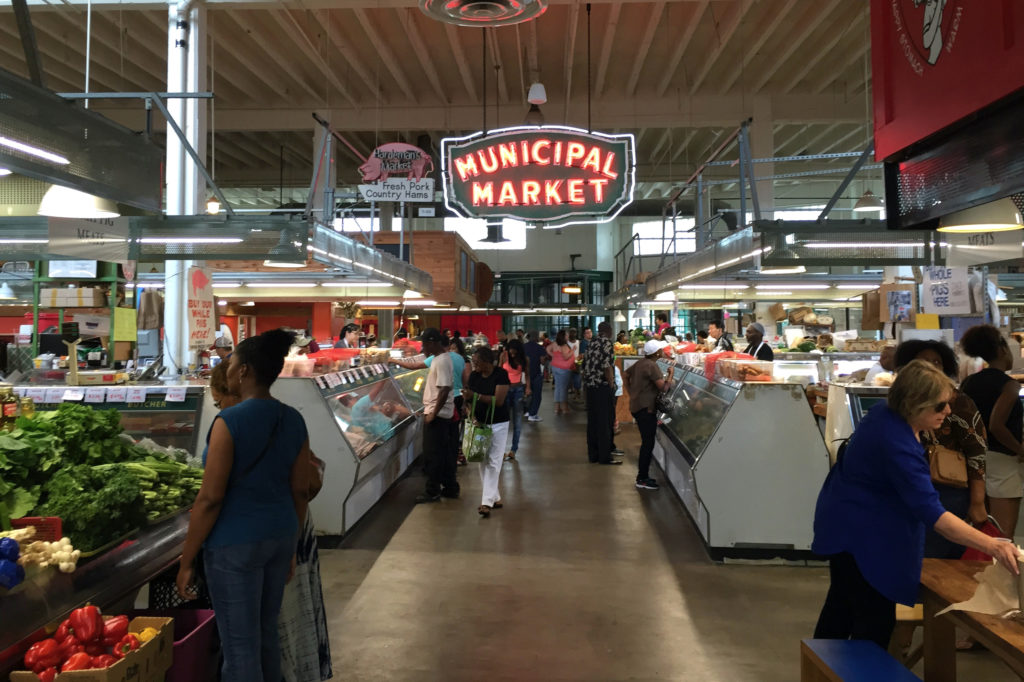
You’ve probably, at some point, visited a farmers market. You can hardly avoid them. There are 8,675 farmers markets in America (up from hundreds in the 1960s) and still multiplying. Since 2011, the number of markets counted by the U.S. Department of Agriculture has grown by 20 percent.
But the markets you’re probably familiar with—neighborhood markets where residents go to buy fresh produce and baked goods directly from farmers—are just one of three kinds of farmers markets. All are important to city dwellers and farmers.
Before getting to the differences, though, a definition. A farmers market is a physical place where farmers—or those representing farmers—sell agricultural products or seafood directly to consumers, restaurants, or wholesalers. There are two key concepts here: a physical place, and the direct sale of produce, meat, baked goods, or seafood. That makes them different from a supermarket, where there are several levels of separation between farm and table. At the neighborhood farmers market, chances are good you are buying tomatoes, pole beans, or cantaloupes from the person who grew and harvested them, often days or hours earlier, not a week before.
As we mentioned, neighborhood markets are only one kind of farmers market. Another is the massive wholesale markets that nearly every city has. The largest of these, not surprisingly, is the 113-acre Hunts Point Cooperative Market in New York. (If that name doesn’t ring a bell, perhaps you’ve heard of one section of Hunts Point, the Fulton Fish Market.) Nearly every city has something like Hunts Point, where wholesalers buy for grocery stores and greengrocers, restaurants buy fresh produce, meat, and seafood for the days ahead, and a few adventurous regular citizens go to see how food flows into their city and maybe find a bargain or two.
The third kind are the iconic city markets, like Pike Place Market in Seattle or the West Side Market in Cleveland. These are a kind of in-between farmers markets. They act a bit like the wholesale markets, because restaurants buy fish and seafood at these places, and a bit like neighborhood markets, because average people shop there for fruits and vegetables. But they are also tourist attractions. Pike Place gets 10 million visitors a year, some of whom are there just to watch the fishmongers toss fish to one another.
What does any of this have to do with government? A lot. The wholesale markets, the ones that cities depend on for much of their food, are most likely owned by a government. New York City, for example, owns Hunts Point and leases land and facilities to tenants. The state of Georgia owns the the State Farmers Market in Forest Park, Georgia, just south of Atlanta.
Why government ownership? One reason is because the key to making these giant markets work is transportation. They need connections to roads, rail lines, and airports. And governments can make these connections easier than private owners.
The city markets that tourists love may or may not be owned by governments but all depend on governments for support. The city of Cleveland owns the West Side Market. Pike Place is governed by a development authority set up by the city of Seattle but which is technically separate. (The mayor appoints four of its 12-member governing board.) Even so, when the market completed a $73 million expansion a few years ago, $34 million of the money came from the city treasury.
So two of the three kinds of farmers markets—the sprawling wholesale markets and iconic city markets—would not exist without government support, including financial assistance. But what about the neighborhood farmers markets, the ones that have grown so fast in recent years? This is where government usually acts as a collaborator, since few of these markets are owned by governments. Often they have nonprofit sponsors. But behind the scenes, local governments are deeply involved in helping out these neighborhood markets by closing streets, providing police protection, waiving business-license requirements for vendors, performing inspections for cleanliness and safety, sometimes even offering space free of charge. (Transit systems are increasingly making space available for farmers markets.) Most governments are happy to do this because fresh produce helps with health issues like obesity, brings neighborhoods together, creates convenience for transit riders, and makes city life more affordable and enjoyable. These are positive externalities, a concept we’ve written about in our entries on public transit and building codes and inspections.
But if farmers markets are almost universally beloved today, their value was not always so obvious to local governments. In the mid-1970s the founder of New York’s highly successful Greenmarkets told journalist John McPhee that when he approached city officials about helping create neighborhood farmers markets, “They seemed to think I wanted to rip them off.”
They changed their minds as they saw how eagerly residents greeted an opportunity to buy produce and fruits directly from farmers. Today GrowNYC, the nonprofit that runs the Greenmarkets, gets $5.6 million of its $16.7 million annual budget from government grants. The remainder comes from foundations, individual donors, farmer fees, and sales of produce and plants. And from a handful of neighborhood markets in the late 1970s, GrowNYC now has 50 full-size markets that connect 240 farmers with a half-million shoppers each week.
This pattern of ownership of wholesale markets and support for city markets and neighborhood markets has been replicated around the country. The result is the astonishing growth of farmers markets since 1970. Governments aren’t the only reason you can buy fresh food directly from farmers in most cities, but they have been essential to their success. And for that, you can give thanks to government.
More information:
https://www.erinnudi.com/2014/05/22/food-history-farmers-markets-2/
https://huetrition.com/blog/farmers-markets-an-introduction/
Give the credit to: local governments 40%, state governments 20%, nonprofits 40%
Leave a Reply